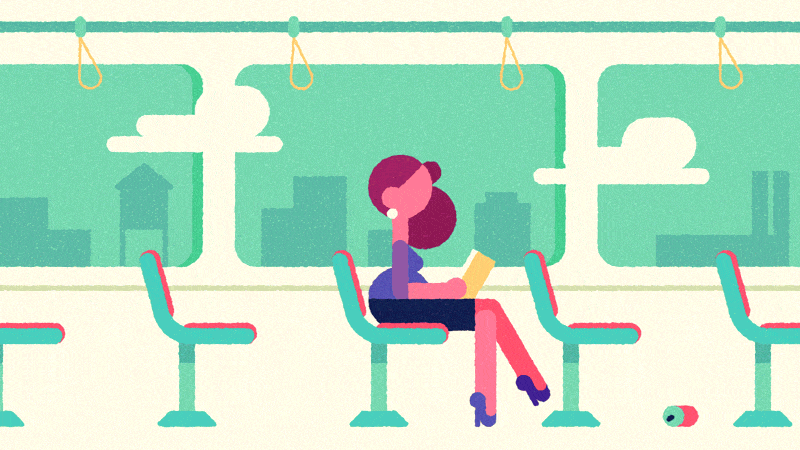
By Alice Park | Sept. 2, 2014
Illustration by Robin Davey for TIME

You’ve already heard that sitting is the new smoking. Now, scientists reveal exactly how it hurts the body—and novel ways to undo the damage (without clocking hours at the gym). You might want to stand up for this.
We like to think we’re a stand-up species. After all, that’s what drove our evolutionary march away from many of our four-legged ancestors. But everywhere we go are invitations to sit down. Hop into your car and what’s there? If you’re lucky, a plush bucket seat designed with just the right tilt for your back. On the subway to work? A less comfortable seat, to be sure, but you’ll grab one if you can. Once at work, an office chair. At home, your favorite fauteuil. But all that hospitality, all those opportunities to give your feet a break, are doing untold things to the rest of your body.
From standing desks and fitness trackers to groundbreaking pilot experiments in high schools in several cities, the movement to sit less and stand more is gaining momentum. Which is a good thing, because new evidence suggests that the more than eight hours the average American spends sitting every day could be exacting a serious—and previously misunderstood—toll.
In the latest look at the benefits of getting on the move — and the dangers of sitting still — researchers found that an hour of moderate activity, such as brisk walking, can offset the harms that sitting for eight hours can have. And there is also data showing that exercise benefits aren’t just for middle-aged and older people but for younger people as well. Andrea Chomistek from Indiana University and her colleagues found in a study published in Circulation that women aged 27 to 44 years old who were more physically active lowered their risk of heart disease over nearly 20 years by 25% compared to women who didn’t exercise. The results bring the dangers of inactivity to a relatively new group — younger women — who normally aren’t at high risk of things like heart disease or diabetes.
It wasn’t how often the women exercised that mattered, but the fact that they did; any activity, including brisk walking, was beneficial.
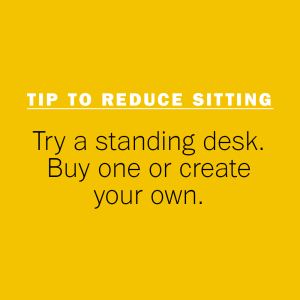 Studies have long connected sedentary behavior to poor health, including heart disease, diabetes, obesity and hypertension. But doctors thought those problems could be traced to the fact that people who sat more were probably just not working out very much. The public health messages were in step with that thinking. “Let’s Move!” became a national mantra.
Studies have long connected sedentary behavior to poor health, including heart disease, diabetes, obesity and hypertension. But doctors thought those problems could be traced to the fact that people who sat more were probably just not working out very much. The public health messages were in step with that thinking. “Let’s Move!” became a national mantra.
But while exercise is critical, it alone can’t make up for the ills of idleness. New research shows there’s a big difference between exercising too little and sitting too much. That’s because a standing body uses energy altogether differently from a sedentary body—and also from an exercising one. We burn calories at a different rate, store them in different ways, and our brains function differently, too. While data is still emerging, one experiment with high school kids found that standing in class instead of sitting improved their test scores by 20%.
All of which has doctors and health experts calling for a paradigm shift. “In the same way that standing up is an oddity now, sitting down should be,” says Dr. James Levine, director of the Mayo Clinic-Arizona State University Obesity Solutions Initiative and probably best known as the inventor of the first treadmill desk. “My argument is that whatever building it is—a movie theater, airport, arts complex—a fundamental part of our thinking has become that people who enter that space will need to be seated.” And that’s what got us into all this trouble in the first place.
This Is Your Body On Sitting
It’s not entirely our fault. As we moved from an active, agricultural lifestyle to one of offices and automated transport, every aspect of our day, from our meals to our jobs and our entertainment, have been adapted with one priority in mind: our comfort. Where our ancestors spent the large bulk of their waking hours on the go, modern life entails sitting for as much as half the day (and that’s not counting sleeping).
The first studies to connect sedentary behavior to poor health emerged in recent decades when scientists started to confirm, in a reproducible way, the effect that extra pounds can have on the body. In these large analyses of men and women of nearly every age, the message was clear: People who spent more hours of the day sitting were more likely to develop a host of health problems.
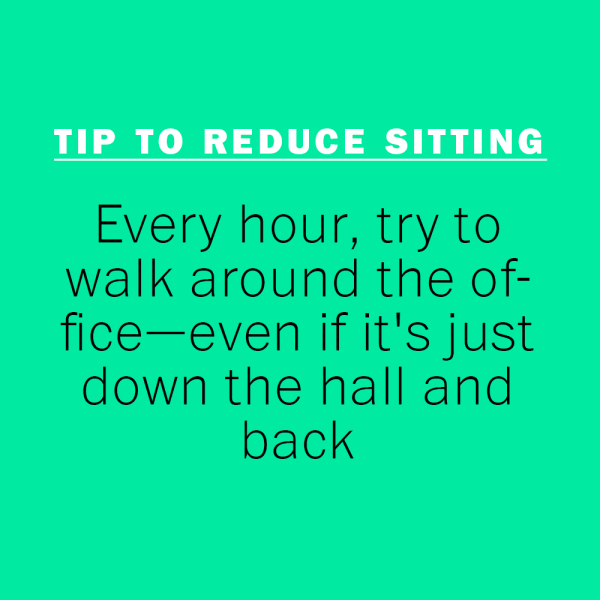 A closer look at that data showed that swapping an hour on the couch for an hour playing catch wouldn’t cut it. A recent review of 43 studies analyzing daily activity and cancer rates found that people who reported sitting for more hours of the day had a 24% greater risk of developing colon cancer, a 32% higher risk of endometrial cancer and a 21% higher risk of lung cancer—regardless of how much they exercised. In another study involving a group of men and women who reported exercising the same amount, each additional hour they spent sitting was linked to a drop in their fitness levels. In other words, sitting was chipping away at some of the benefits of exercise.
A closer look at that data showed that swapping an hour on the couch for an hour playing catch wouldn’t cut it. A recent review of 43 studies analyzing daily activity and cancer rates found that people who reported sitting for more hours of the day had a 24% greater risk of developing colon cancer, a 32% higher risk of endometrial cancer and a 21% higher risk of lung cancer—regardless of how much they exercised. In another study involving a group of men and women who reported exercising the same amount, each additional hour they spent sitting was linked to a drop in their fitness levels. In other words, sitting was chipping away at some of the benefits of exercise.
That’s an important realization. The human body consumes energy in three main ways: every cell needs energy to go about its daily business, whether it’s a muscle cell that contracts and flexes or a liver cell that produces enzymes; we also need to break down the food that we eat; finally, we need energy to move, whether we’re pulling on a shirt or riding a bike. That latter energy—let’s call it activity energy—is further divided into the sweat-inducing kind that you use on the treadmill or in yoga and another kind, which scientists have cleverly called NEAT: non-exercise activity thermogenesis. This includes nearly everything you do requiring movement: folding the laundry, walking up a flight of stairs, running to catch a train, even fidgeting.
The human body is designed to move, and a moving body is a needy body, siphoning off calories to make sure every cell is doing what it’s supposed to do. But even when we’re not exercising, we’re moving and using energy. That’s why NEAT matters. A body that’s sitting isn’t expending energy, so the signals that normally result in you moving—and which, in turn, burn calories—start to check out, molecularly bored with not being called into duty. Meanwhile, the processes that build up fat get busier. When that happens, it gets harder and harder to get off the chair.
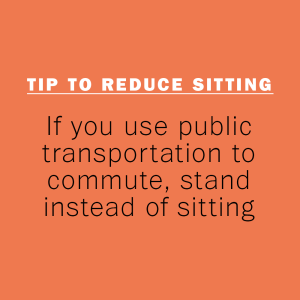 The other signals that keep us rooted on our rears may originate in the brain. In animal studies, obese rats seemed to have a switch that prevented them from burning NEAT calories efficiently. The reason why isn’t clear yet, but researchers are studying the brain signals that govern what makes us more likely to move—or not move—to answer it.
The other signals that keep us rooted on our rears may originate in the brain. In animal studies, obese rats seemed to have a switch that prevented them from burning NEAT calories efficiently. The reason why isn’t clear yet, but researchers are studying the brain signals that govern what makes us more likely to move—or not move—to answer it.
That could help explain, at least in part, why too much sitting seems to be so bad for the human body. People who sit at their desks most of the time, for example, only polish off 300 NEAT calories a day compared to, say, a coffee shop barista who spends most of his or her shift standing—and burning up to 1,300 extra calories daily.
There’s also intriguing evidence that sitting less may short-circuit some bodily processes that lead to diabetes. When we eat meals, our bodies experience a surge in blood sugar that peaks about an hour after we eat. If we’re sedentary and relatively immobile, our muscles and cells aren’t soaking up that glucose to fuel its daily activities. So all that extra sugar gets turned into fat. If we take a walk after lunch, however, some of that sugar is burned off in order to keep us on our feet and propel us forward. The less sugar that’s left after that activity, the less that gets turned into fat and contributes to obesity and eventually diabetes.
Becoming a body in motion
Even if you’re wired in some ways to sit, can you become a stand-up person? Absolutely, says Levine. Just as sedentary behavior can change the brain and body to prefer sitting, getting up and becoming more active will prompt you to want to stay in motion. And that can have benefits on productivity and possibly creativity as well, although while the data on the harms of sitting are pretty well documented, the productivity benefits are still anecdotal. But researchers, including Levine, are working on that.
In Rochester, Minn., for example, Levine conducted an experiment with the help of Apple, which donated computers and other supplies, on a School of the Future concept that rethought the classroom model of kids sitting at attention. Instead, the kids stood and moved. Levine and his team strapped sensors to the legs and backs of students to measure their NEAT levels. The students had mobile stations that held their laptops, which they could move around the classroom. Benches let the kids sit when the wanted to, but the default was clearly toward standing and moving.
After two months, the teachers reported that the students took fewer bathroom breaks, engaged in less frivolous movement, and related better to each other. Parents also noticed a difference. They said, almost unbelievable, that their children came home more eager to do homework and less stressed after their day. And what did the NEAT sensors show? The children doubled their activity level compared to when they were in a traditional classroom. Finally, the pioneering students scored up to 20% higher on state standardized tests than they had previously.
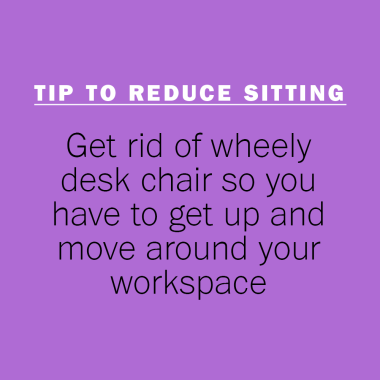 Even if you don’t have the help of Apple or a forward-thinking boss to transform your workplace, there are ways to make yourself get up. For the more ambitious, there’s changing your work station to a standing one (see how one TIME staffer did the same by reading this story). But even simply fielding phone calls on your feet is a good way to start, or pacing while you talk. You could also keep a small glass of water on your desk so you’re inclined to get up more frequently to refill it, taking walks around the office or your home while you’re at it. For the more ambitious, says Levine, urge your colleagues to try standing meetings.
Even if you don’t have the help of Apple or a forward-thinking boss to transform your workplace, there are ways to make yourself get up. For the more ambitious, there’s changing your work station to a standing one (see how one TIME staffer did the same by reading this story). But even simply fielding phone calls on your feet is a good way to start, or pacing while you talk. You could also keep a small glass of water on your desk so you’re inclined to get up more frequently to refill it, taking walks around the office or your home while you’re at it. For the more ambitious, says Levine, urge your colleagues to try standing meetings.
“By simply changing your work style, from a chair-based work style to a [standing] one, you can burn 500 to 1,000 extra calories a day,” he says. And it’s not just the calories that count. One study found that regardless of how many hours a group of men spent sitting daily (in their cars or watching TV), those with higher fitness levels – which is, of course, a product of regular exercise – did not show an increased risk of metabolic syndrome, the suite of conditions that include obesity and high cholesterol and are associated with a higher risk of heart disease.
How do you turn your sitting day into a standing one? In 2000, Levine addressed the office chair culture head on when he and a colleague raided the Mayo Clinic basement, where old and broken furniture was stored, and with some duct tape and a saw, put together a patient table that could be adjusted for height with a Sears treadmill to make the first treadmill desk. After some number crunching, he figured out that the optimal speed for writing and walking was about 1 mph, so he adjusted the speed of his contraption to keep his fingers and feet moving without falling off the device.
Now, there are far fancier versions of the treadmill desk that allow you to switch between desk and full treadmill mode (minus the duct tape). And they’re becoming less of an oddity.
“What we need to do is change the default,” Levine says. “I want us to have to find excuses to be sitting down.” Imagine that. Maybe standing really could be the new sitting.
![]()
By Katy Steinmetz
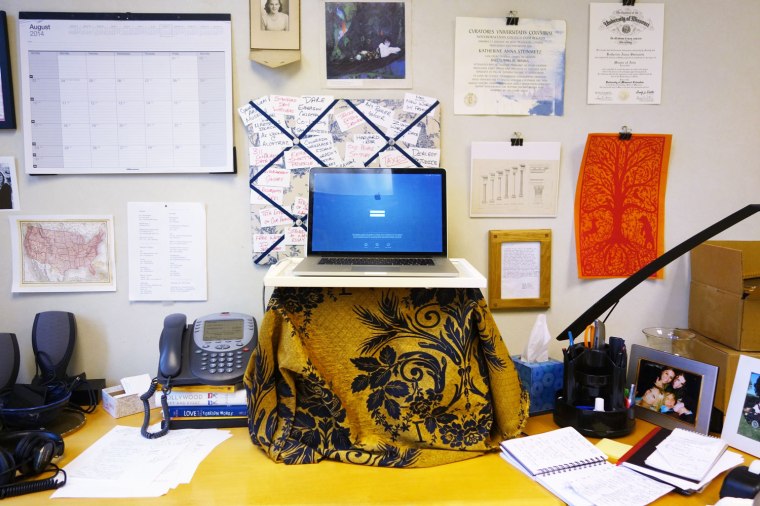
Sure, these contraptions can cost hundreds. But they don’t have to
If I personally shut down all the hoodie factories in the world, so long as I did it standing up, that would probably be more acceptable in the Bay Area than the fact that until recently, I spent all day sitting.
Earlier this year, I toured Silicon Valley to report on the borderline ridiculous things that tech companies are doing for their employees in the name of health. Free juice bars, giant two-person tricycles, on-site chiropractors. As HR administrators listed off the evils they must fight—stress, work-life imbalance, the draw of corn chips—I probably heard more than anything else about the perils of being on one’s behind for hours at a time.
I was prepared for this assignment to make me feel like a schlub. Because I do not, for instance, meditate to reduce my stress, and I do not bike to work to stay fit. I don’t use vibrating forks to slow my eating speed. And I certainly don’t have a life coach (unless you count lyrics of Janet Jackson songs). But still, I was not prepared to have my chair-using habit held up as the paragon of bad health. That, and the fact that I was doing this terrible thing for roughly a third of my day, made me all the more determined to make a change when the reporting was done.
At companies such as Google, there are tools employees can call upon to minimize their time spent sitting. There are motorized desks that can be adjusted to a standing height. There are treadmill desks on which employees can stroll while pecking at their laptops. There are ergonomics teams one can call in like a SWAT unit to measure all their body parts to make sure the employee is standing as comfortably as possible.
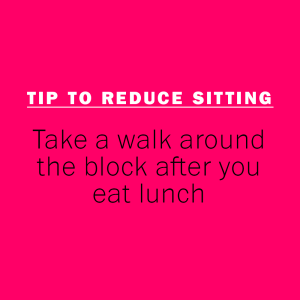 Such is not the case in my San Francisco office, where the average everyday perk is somewhere between all the AAA batteries I could ever want and a very reliable elevator. I didn’t know quite where to start. I wasn’t going to call up my boss and ask if I could expense a $300 desk accessory that would elevate my laptop, and I certainly wasn’t going to inquire about the $1,500 LifeSpan TR1200 treadmill desk—because I would, rightly, be laughed out of print media.
Such is not the case in my San Francisco office, where the average everyday perk is somewhere between all the AAA batteries I could ever want and a very reliable elevator. I didn’t know quite where to start. I wasn’t going to call up my boss and ask if I could expense a $300 desk accessory that would elevate my laptop, and I certainly wasn’t going to inquire about the $1,500 LifeSpan TR1200 treadmill desk—because I would, rightly, be laughed out of print media.
So I went foraging in the office space. First, I tried putting a chair on my desk, where I would defiantly place my computer in a poetic statement about my refusal to use such office furniture in the conventional way any longer. It was too tall. I tried old boxes, which proved insufficiently sturdy and a giant roll of bubble wrap, which proved very noisy. After attempting to build towers out of differently sized books and old magazines, my eyes finally landed on the glorious solution, sitting there in front of me the whole time: trash cans.
I discovered that two upside-down standard-sized cans were just right for my 15” laptop and my 5’3” frame. To create a sturdy top, I placed an office-warming gift—a framed poster of the state of California—on top. I rolled my office chair into a corner and voila: I had the ugliest low-budget standing desk this side of Jerry Brown.
My first surprise: No more shoes at work. I’m a lady and all, but I wasn’t going to stand for nine hours in the high heels that I have long worn to make my calves more presentable during daily trips to and from the local sandwich shop. Even barefoot, my feet got sore the first few days—and so I bought an anti-fatigue mat. (It’s worth investing in a decent one, like this Imprint number I got from Amazon for $56).
A kind former colleague offered me her Time Inc. brand towel, a black and blue thing that hid my furniture’s true identity but made me look like a dork who decorates her office with on-brand towels. To get more suitable decoration, I took to the local tapestry shop in the Russian Hill neighborhood. In the basement, I dug through remnants of fabric cast off by other buyers and found a lovely gold and black piece that would do the job for $10. And with that my anti-backside experiment was ready to commence.
The results came in quickly. I had more energy throughout the day. I didn’t get sleepy after lunch. My voice projected better on the phone. I could spontaneously break into dance with ease. I found myself taking more trips to the copy room and mailroom because, hey, I was already up, so why minimize my trips? And when I went home to binge-watch Orange Is the New Black, I didn’t feel so guilty for sitting in the evening. I was earning it.

After the standing went on for a few weeks, I permanently rolled my chair out of the office, like a smoker who finally throws away the backup pack. And after a few months, my fiancé was the first to notice that my buns had gotten firmer and my quads were stronger.
I had gone into the project knowing that standing just three hours per day for a year was the equivalent of running 10 marathons, but I hadn’t expected to see actual changes in my body so quickly.
And so here I am, a true stander-and-worker. And I’m never going back.
